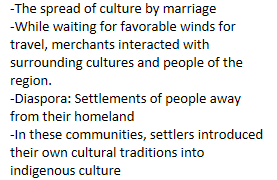AP MODERN HUMAN GEO UNIT 2
5.0(1)
5.0(1)
Card Sorting
1/37
There's no tags or description
Looks like no tags are added yet.
Study Analytics
Name | Mastery | Learn | Test | Matching | Spaced |
|---|
No study sessions yet.
38 Terms
1
New cards
When were the Silk Roads revived?
The 8th and 9th centuries
2
New cards
Demand of Luxury Goods
Demand for luxury goods increased in Europe and Africa, and Chinese, Persian, and Indian artisans and merchants expanded the production of textiles and porcelains for export.
3
New cards
First Golden Age of Silk Roads
* Came to an end after the collapse of classical civilizations (Roman and Han empires), and activity declined dramatically.
\
\
4
New cards
Silk Road Background
Caravans made travel safer and more practical, and the Chinese developed a system using paper money to manage increasing trade.
5
New cards
Who revived the Silk Roads?
Arab merchants from the Abbasid Empire revived the land route of the Silk Roads and sea routes in the Indian Ocean.
6
New cards
Tang China
offered compass, paper, and gunpowder to the newly revived global trade network, and exported porcelain, tea, and silk.
7
New cards
Trading in Asia
* From other parts of Asia, China imported cotton, precious stones, pomegranates, dates, horses, and grapes.
* Luxury goods appealed to the upper class of Chinese society, whose members celebrated their country's newfound affluence.
* Luxury goods appealed to the upper class of Chinese society, whose members celebrated their country's newfound affluence.
8
New cards
Crusades
Helped expand networks of exchange, as lords and their armies of knights brought back fabrics and spices from the East
9
New cards
The Rise of the Mongol Empire
Europeans had not yet found a route around Cape of Good Hope (the southern tip of Africa), but had been making overland trips across Europe for many centuries other causes had as significant an impact on the expansion of trade as the rise of the **Mongol Empire**.
10
New cards
Lateen Sail
The Lateen Sail is a technology created for traveling across the Indian Ocean trade routes. This sail was
11
New cards
Important regions in the Silk Roads?
Europe, Africa, Asia, Middle East
12
New cards
Important regions in the Indian Ocean
East Asia, India
13
New cards
Important regions in the Trans- Saharan
Timbuktu and Egypt
14
New cards
Silk Roads Goods
Dates, spices, stones, pomegranates, sugar, slaves, silk and porcelain, tea, paper and gunpowder, horses and textiles.
15
New cards
Silk Road Tech
Magnetic compass, champa rice, saddles, caravanserai
16
New cards
Silk Road religion
Christianity, Islam, buddhism, neo confucianism
17
New cards
Important cities in Silk Roads
Caravanserai, Samarkand and Kashgar
18
New cards
Goods in Indian Ocean
Spices, cotton, high carbon steel, horses, figs, dates, silk, porcelain, slaves, ivory, gold, animal skins
19
New cards
Indian Ocean Tech
Lateen sail, sturn rudder, small wooden dhows, astrolabe tool
20
New cards
Indian Ocean religion
Islam, buddhism, christianity, neo- confucianism
21
New cards
Indian Ocean cities
Calicut, Cambay, Malacca, Analaysia, Iran & Egypt
22
New cards
Trans- Saharan goods
Salt, cotton, horses, books, gold, ivory
23
New cards
Trans- Saharan tech
caravan, camels & sadels
24
New cards
Trans Saharan religion
islam
25
New cards
trans saharan
timbuktu, cordoba, mali and egypt.
26
New cards
The negative impact of the Mongols
Brought Black death/bubonic plague that killed 1/3 of europe population and 2 million in China. They had a reputation of killing people, death, and destruction.
27
New cards
The positive impact of the Mongols
Brought prosperity and made trade and travel through the Silk Roads popular. Spread of Islam and new innovations and trade. Sharing of culture.
28
New cards
Monsoon winds
Unpredictable winds that would travel north and south through summer and winter. The Lateen sail is an invention used in the Indian Ocean that would go against the winds and could travel whichever way.
29
New cards
Genghis Khan
A ruthless leader in Mongolia killed many people that were in his way. Hired artisans to work in his empire instead of killing them to benefit him. Had three grandsons Batu, Hulegu, Kublai Khan.
30
New cards
Indonesia
Spice Island in India
31
New cards
Slavery in the Indian Ocean
Transported from Africa to Middle East through Indian Ocean. Slaves sometimes worked as sailors inside households or sometimes along with free people.
32
New cards
Malacca
Muslim city state that charged ships who passed by the Strait of Malacca and became very wealthy.
33
New cards

The spread of Islam through the Indian Ocean
use image as reference
34
New cards
$ Through Taxing Trade
Port cities like Malacca, Zanj, and Guajarat begun taxing trade through port cities which increased wealth.
35
New cards
Zheng He
Explorer from the Ming Dynasty that wanted to express might of Ming Dynasty and receive tribute. His explorations were controversial and soon banned due to challenging ideas of confucianism and bringing new ideas that might change Ming’s social order.
36
New cards
Camels and Saddles in the Sahara Desert
In Arabia, saddles were created to maintain balance on hump and see better. In East Africa, saddles were created to carry up to 600lbs of weight.
37
New cards
Caravans
Caravans used to bring large group of people to Oasis (water source) 7 south routes and 2 east-west routes
38
New cards
Mansa Musa
Mansa Musa was extremely wealthy and still the wealthiest person ever lived. He brought back Islam religion and schools and mosques.